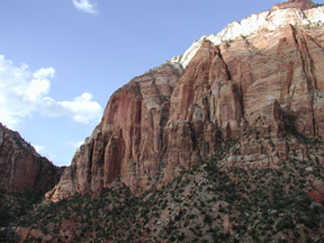
Geotimes Home | AGI Home | Information Services | Geoscience Education | Public Policy | Programs | Publications | Careers

 The famous red and
yellow cliffs of Zion National Park in Utah expose thousands of feet of early
Jurassic Navajo sandstone, one of the largest wind-deposited formations in the
geologic record. The vast sand sea from which the sandstone hardened is estimated
to have once covered up to 400,000 square kilometers, an area the size of California.
The famous red and
yellow cliffs of Zion National Park in Utah expose thousands of feet of early
Jurassic Navajo sandstone, one of the largest wind-deposited formations in the
geologic record. The vast sand sea from which the sandstone hardened is estimated
to have once covered up to 400,000 square kilometers, an area the size of California. |
Geotimes Home | AGI Home | Information Services | Geoscience Education | Public Policy | Programs | Publications | Careers |